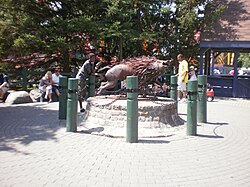| Wilde Beast | |
|---|---|
| Previously known as Wilde Beast (1981-1996), then Wild Beast (1997-2018) | |
 "Wilde Beast" sculpture by Bill Lishman, at the ride's entrance | |
| Canada's Wonderland | |
| Location | Canada's Wonderland |
| Park section | Medieval Faire |
| Coordinates | 43°50′38.94″N79°32′35.37″W / 43.8441500°N 79.5431583°W |
| Status | Operating |
| Opening date | 1981 |
| Cost | $1.2 million |
| General statistics | |
| Type | Wood |
| Manufacturer | Taft Broadcasting Company |
| Designer | Curtis D. Summers |
| Track layout | Out and Back/Figure 8 |
| Lift/launch system | Chain lift hill |
| Height | 25 m (82 ft) |
| Drop | 23.8 m (78 ft) |
| Length | 960 m (3,150 ft) |
| Speed | 90 km/h (56 mph) |
| Inversions | 0 |
| Duration | 3:00 |
| Height restriction | 122 cm (4 ft 0 in) |
| Trains | 2 trains with 7 cars. Riders are arranged 2 across in 2 rows for a total of 28 riders per train. |
| Wilde Beast at RCDB | |
Wilde Beast is a wooden roller coaster located at Canada's Wonderland, in Vaughan, Ontario, Canada. It was originally named "Wilde Beast", [1] [2] from 1981 to 1996, when it was renamed to "Wild Beast" in 1997. The ride was reverted to its original name in 2019. [3] [4] It is one of the five roller coasters that debuted with the park in 1981, and is one of three wooden coasters at Canada's Wonderland modeled after a ride at Coney Island amusement park in Cincinnati, Ohio (specifically, Wildcat); the other is the Mighty Canadian Minebuster. The ride's fan curve was rebuilt in 1998.[ citation needed ]